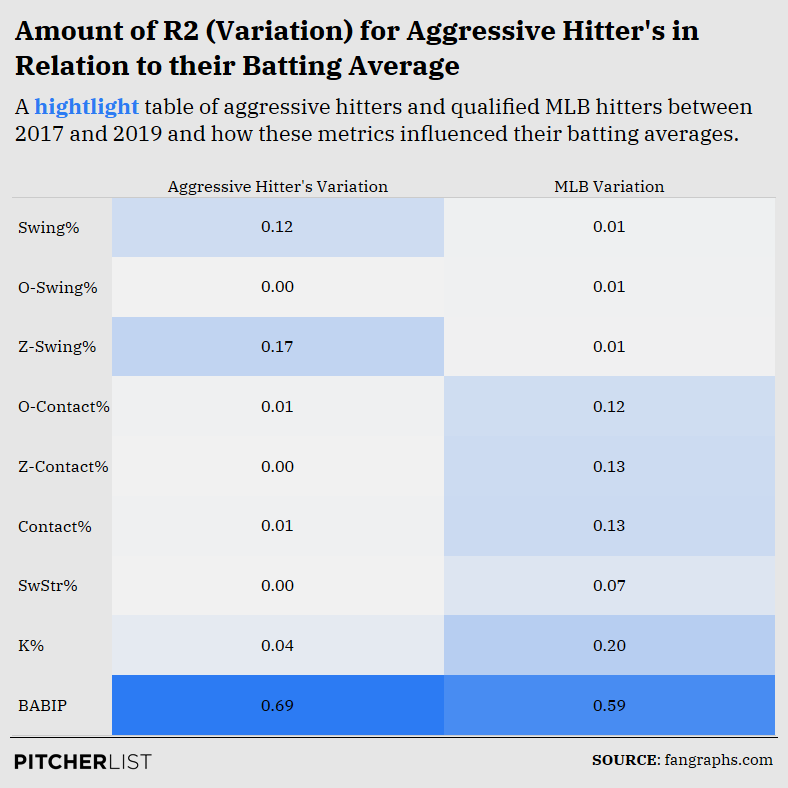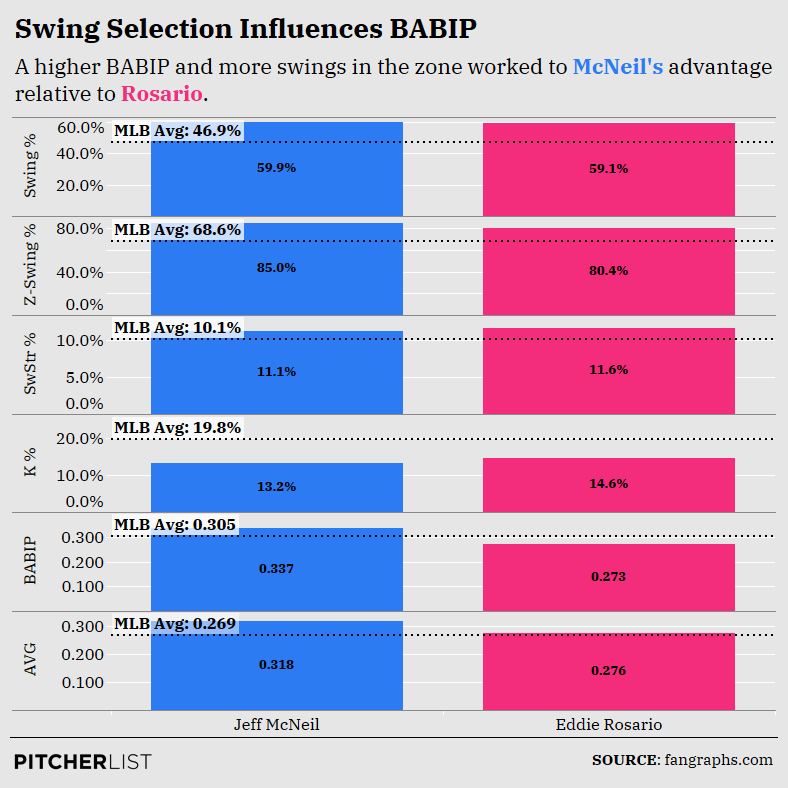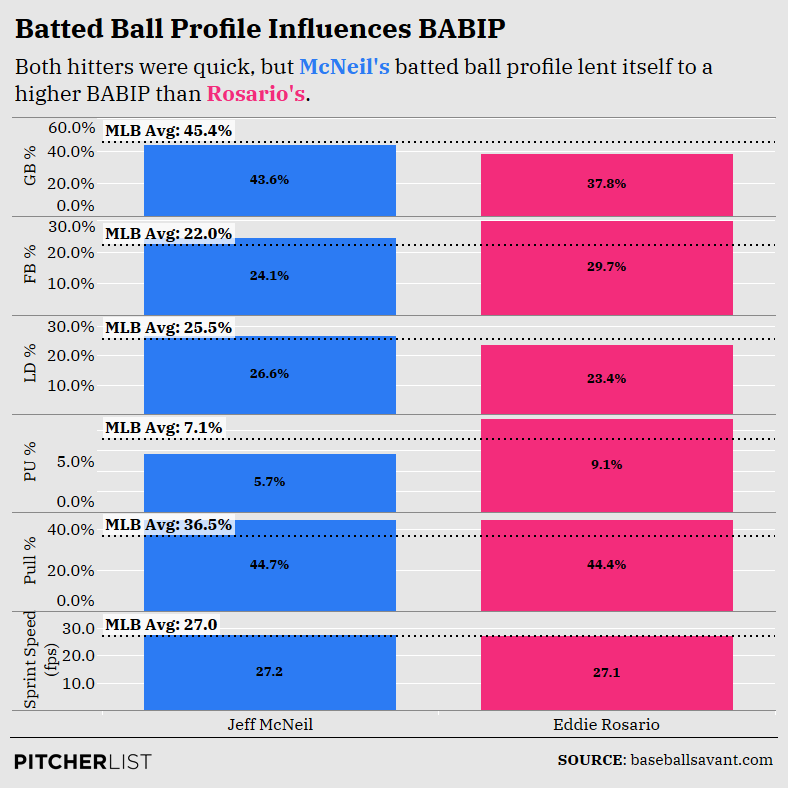The other day, I was listening to one of my favorite podcasts, Rates & Barrels, and Eno Sarris mentioned that, a few years ago, he wouldn’t look twice at a hitter like Byron Buxton. Buxton maintains high strikeout rates, swings a lot, swings and misses often, likes to chase pitches off the plate, and walks infrequently. In short, his plate discipline is terrible.
However, Eno concluded that, in today’s game, some similar hitters are able to maintain excellent batting averages—and, accordingly, stellar fantasy value—in spite of poor plate discipline. Look no further than Javier Báez, who hit .281 and .290 the prior two seasons, despite extremely high swing, swinging-strike and chase rates, and low walk rates.
Last week, I wrote about patient hitters (those with low swing rates) and found that they do not succeed, on average, more than other hitters in terms of batting average. They take more called strikes than their counterparts and, accordingly, sustain higher strikeout rates than their swinging-strike rates would portend. However, they can compensate for those called strikes by running exceptionally high BABIPs, high Z-Contact rates, or low swinging-strike rates.
This week, I’ll tackle aggressive hitters like Buxton and Báez to see whether they are more or less successful than their patient counterparts. I’ll also determine what separates the successful aggressive hitters from those who are batting-average liabilities for their fantasy squads.
High Swing%
To obtain a sufficient sample of hitters with aggressive approaches at the plate, I found the 60 players with the highest single-season swing rates dating back through 2017. Interestingly, Jeff McNeil had the highest mark of all three years with a 59.9% swing rate in 2019.
Then, I found the averages for this group of various plate discipline and other metrics that relate to batting average. For context, the first row of the following table contains the averages of the 60 players with the highest single-season swing rates, while the second row contains the averages for all qualified hitters from 2017-19.
| Swing% | O-Swing% | Z-Swing% | O-Contact% | Z-Contact% | Contact% | SwStr% | K% | BB% | BABIP | AVG | wRC+ | |
|---|---|---|---|---|---|---|---|---|---|---|---|---|
| Sample Average | 54.9% | 40.3% | 75.3% | 66.3% | 86.3% | 77.7% | 12.3% | 18.7% | 5.4% | 0.313 | 0.279 | 105 |
| 2017-19 MLB Average | 46.9% | 30.9% | 68.6% | 65.2% | 86.6% | 78.5% | 10.1% | 19.8% | 9.1% | 0.305 | 0.269 | 112 |
Perhaps the most salient aspect of this table is that these 60 hitters fare far better in terms of batting average than the entire sample of qualified hitters dating back through 2017. Indeed, ten points of batting average is no fluke. Certainly, eight additional points of BABIP doesn’t hurt. Yet, just because they run higher batting averages, doesn’t mean they’re more successful hitters. In fact, they averaged a worse wRC+ than all qualified hitters during this period.
One additional item of note is that these players swing out of the zone almost a third more often than the rest of the league. However, that hasn’t had an impact on their BABIPs which, as noted above, are higher than the league average. One conclusion we can draw, then, is that chasing pitches out of the zone doesn’t necessarily yield contact that is less-susceptible to reaching base. An alternative conclusion would be that these hitters swing at enough good pitches, in light of their relatively high Z-Swing rates, to compensate for their chases.
I would also highlight that these hitters run higher swinging-strike rates and lower strikeout rates than the MLB average. This likely feeds back into what I wrote last week. Patient hitters see more called strikes (and balls) and therefore have higher strikeout rates (and more walks) than we would expect based solely on their swinging-strike rates. Similarly, these 60 hitters, by swinging more often, put more balls into play. That also means that they take fewer pitches and get into fewer deep counts. By taking fewer called strikes and balls than other hitters, they strike out less and walk more frequently.
That also means they strike out less than we would otherwise expect based solely on their swinging-strike rates. I ran a regression in the entire sample of qualified hitters to find a formula for predicted strikeout rate based on swinging-strike rate. Plugging in the 12.3% mark above yields a 22.7 K%, yet these 60 guys average 18.7% — lower than the MLB average. Therefore, they need not maintain swinging-strike rates as low as other hitters to have similar or lower strikeout rates because they end counts earlier by putting more balls into play (and, incidentally, seeing fewer called strikes). So, when you evaluate a hitter and his swinging-strike rate is higher than what you’d expect based on his strikeout rate, check to see if he’s an aggressive hitter. If so, I wouldn’t expect strikeout regression in the near future.
Benefiting from Aggression
Next, we’ll determine what separates those aggressive hitters with high batting averages from those with low batting averages.

Data Visualization by Nick Kollauf (@Kollauf on Twitter)
The first column shows the amount of variation in these 60 aggressive hitters’ batting averages explained by each metric on the left. In other words, now we’ve isolated high swing% hitters and we’re saying, among them, which metrics influenced their batting averages the most? The second column does the same, but for the entire sample of qualified hitters in MLB from 2017-19.
Think back for a moment to last week’s article on patient hitters. Their strikeout rates, swinging-strike rates, and Z-Contact rates explained 27.9%, 22.9%, and 29.9% of the variance in their batting averages, respectively. Whereas here, the ability to make contact matters extremely little, if at all, for patient hitters. The R2 for their strikeout, swinging strike, contact, Z-Contact, and O-Contact rates show that, once we control for aggressive hitters, those metrics have no influence on their batting averages. They can swing and miss as much (or as little) as they like.
Beyond this, these 60 players’ swing rates explained 12% of the variation in their batting averages. Plotting their swing rates against batting averages shows a positive relationship. Therefore, if you’re already a high swing% hitter, swinging more (to a nominal degree) results in a higher batting average relative to your high swing rate peers. And, the same can be said for Z-Swing%, but to an even greater degree (17%). Consequently, maintaining plate discipline does matter for aggressive hitters’ batting averages, but only to the extent they’re swinging at pitches in the zone. O-Swing rate does not matter and swing rate does not tell a sufficiently specific story.
What jumps out the most from this table, though, is BABIP. As discussed above, aggressive hitters tend to run higher BABIPs than the league at large. Fluctuations in their batting averages are also more dependent on BABIP than the rest of the league. That’s not surprising given that their strikeouts have extremely little influence on their batting averages. However, this is also begs an interesting question: Are aggressive hitters’ BABIPs higher because they’re more aggressive and swing more, or do they choose to be more aggressive because they have the ability to run higher BABIPs?
It’s not entirely clear whether we’re dealing with the chicken or the egg, but there’s at least one clue. Isolating these 60 aggressive hitters and running a regression between their swing rates and their BABIPs produces a low 0.05 R2. Doing the same for Z-Swing% and BABIP likewise illustrates a weak relationship: 0.06 R2. To summarize, BABIP is highly significant for discerning between aggressive hitters’ batting averages, but is itself not influenced by whether they swing more or swing more at pitches in the zone.
Successful Aggressive Hitters
If hitters run higher BABIPs independently of their swing rates, then let’s see which hitters are making smart choices. Put differently, let’s determine which hitters wisely choose to swing more in light of their ability to produce a high BABIP, and which should swing less.

Data Visualization by Nick Kollauf (@Kollauf on Twitter)
Consider McNeil and Eddie Rosario’s 2019 seasons. Both were at the upper echelon of swing rates among aggressive hitters, with McNeil first and Rosario third among all 60. They had similar swinging-strike rates, but McNeil swung more in the zone. That worked to McNeil’s advantage, as he also maintained a much higher BABIP and, consequently, batting average. In other words, as a high BABIP hitter, McNeil smartly swung often — and more frequently at pitches in the zone—putting a lot of balls into play to maximize his batted ball profile.

Data Visualization by Nick Kollauf (@Kollauf on Twitter)
In the above table based on Statcast metrics, you can easily see why McNeil had the better BABIP. Both hitters were slightly faster than the MLB average, which is conducive to a higher BABIP, and both pulled the ball less often than the average hitter, which depresses their BABIPs. However, McNeil hit more line drives and ground balls — higher BABIP batted ball types — and fewer pop-ups than the average hitter. While Rosario hit far fewer ground balls and line drives and way more fly balls and pop-ups than the average hitter.
Were McNeil to adjust his approach to become less pull-oriented, he could run an even higher BABIP. Yet, as is, he’s fast enough, avoids low BABIP batted ball types, and hits sufficient ground balls and line drives to maintain an elevated BABIP. Therefore, he should (and does) swing often to put the ball in play as much as possible. Conversely, Rosario has the makeup of a low BABIP hitter because he orients his approach to pulled fly balls, which are easy outs when they aren’t home runs, and which also generates many pop-ups and flyouts. Rosario also does not put enough ground balls or line drives into play relative to other hitters. Accordingly, he would be better-served with selectivity. Instead, he not only runs a low BABIP, but also puts a ton of balls into play that are quick outs by swinging so frequently.
Conclusion
Aggressive hitters tend to run higher BABIPs and batting averages (but average a lower wRC+) than the rest of the league. They take fewer called strikes than their counterparts, and, accordingly, sustain lower strikeout rates than their swinging-strike rates would suggest. In terms of batting average, it doesn’t matter that they often chase pitches out of the zone as well.
Aggressive hitters can best take advantage of their lower strikeout rates and the increased quantity of balls in play if they have plate approaches geared toward higher BABIPs. If they don’t, they should probably consider a change in approach, either by becoming more selective or gearing their swings for more ground balls and line drives. It’s not enough to just swing more. With aggression must come proper contact management to maintain a higher batting average.
Photo by Bryan Singer/Icon Sportswire | Adapted by Justin Paradis (@freshmeatcomm on Twitter)

Thank you for this article.
I am a big Javier Baez fan and have followed him for a long time. Early in his career lots of pundits talked about his poor plate discipline. I think an error that a lot of pundits had on Baez is speaking interchangeably about strike zone and plate discipline like they are two sides of the same coin … it implies that the only good pitches to hit are in the strike zone. That is not true. At the simplest, most basic level, the strike zone is where pitches count for strikes… that is it. Plate discipline CAN be about focusing on swinging at pitches in the strike zone, but it is also about a batter knowing what pitches they are effective at hitting OUTSIDE the strike zone … some of these pitches may or may not be in the strike zone. In the old days they called these kind of guys “bad ball hitters”.
It is, and remains to be, a competitive advantage understanding in fantasy who the bad ball hitters are… Javier Baez is at the top of the list. I think it would be great to see further analysis on this subject.